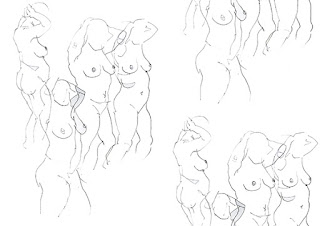sodium hydroxymethylsulfinate
Na+HOCH2SO2
DISCHARGE
PRINTING & ILLUMINATED DISCHARGE

The technique depends on the fact that some dyes may be chemically removed from the dyed fabric using a discharge agent, to leave a corresponding white area. The necessary discharge agent is mixed with a colour-free printing paste and the pattern printed on to the previously dyed fabric as usual. Drying or streaming and then washing follow. For illuminated styles a discharge resistant dye is incorporated into the paste so that discharge and coloration with the illuminating color occur simultaneously.
 In addition to the simple application of
dye, I found that textile printing offered certain techniques that could be used to create and obtain experimental effects. In an attempt to discover ways
in which my designs could be transferred to fabric (other than using a digital
print process), I attempted to incorporate methods which were more ‘hand
rendered’, replicating traditional development of patterns, rather like
painting onto a canvas.
In addition to the simple application of
dye, I found that textile printing offered certain techniques that could be used to create and obtain experimental effects. In an attempt to discover ways
in which my designs could be transferred to fabric (other than using a digital
print process), I attempted to incorporate methods which were more ‘hand
rendered’, replicating traditional development of patterns, rather like
painting onto a canvas.
It was possible to produce intricate
printed patterns on a coloured background using fabric which has been coloured
at the manufacturing stage or hand dyed. I chose to hand dye a range of fabric samples
and used a variety of natural fibres – Lawn Cotton, Calico, Japanese Linen and
Silk.
This was all about chemistry and chemical reactions. There were test tubes, scales and phials of powdered oxides in preparation for constructing my
designs. After boiling up a range of selected fabric in steel bowls the addition of
hot water dye produced rich, deep hues. Blue, violet and orange worked exceptionally
well as background colours with silk being the best fibre to ‘hold’ the colour,
achieving a vibrant area to print on to.
 It seems that a better ‘Discharge print’ is achieved by hand when using natural fibres and this form
of printing appears to be most effective where you wish to achieve small areas of intricate detail
on a large area of background colour.
It seems that a better ‘Discharge print’ is achieved by hand when using natural fibres and this form
of printing appears to be most effective where you wish to achieve small areas of intricate detail
on a large area of background colour.
 The contrast and colour of the patterns
created depended on the discharge chemical medium used. White was achieved
where the discharge medium bleached out sections of the original fabric colour
and a contrasting colour was achieved when using Illuminated discharge medium –
I used blue, lilac and red.
The contrast and colour of the patterns
created depended on the discharge chemical medium used. White was achieved
where the discharge medium bleached out sections of the original fabric colour
and a contrasting colour was achieved when using Illuminated discharge medium –
I used blue, lilac and red.
It was possible to hand paint, stencil and
screenprint directly onto my background fabric (which was first pinned out flat onto the textile table) with the discharge chemicals. I
attempted a combination of all three of these techniques.
Also using ‘found’ objects coated in discharge medium, which I rolled onto calico fabric, for example, washers, bolts, plastic bottle tops and metal springs, produced interesting effects. Personally, the experimentation and anticipation outweighed the conclusion to my experiments. In fact, the end result achieved after the fabric was pinned, rolled, steamed and then washed was disappointing and crude in appearance. I preferred the subtleties in detail and tone of the painted and printed discharge medium before the finishing process.
Also using ‘found’ objects coated in discharge medium, which I rolled onto calico fabric, for example, washers, bolts, plastic bottle tops and metal springs, produced interesting effects. Personally, the experimentation and anticipation outweighed the conclusion to my experiments. In fact, the end result achieved after the fabric was pinned, rolled, steamed and then washed was disappointing and crude in appearance. I preferred the subtleties in detail and tone of the painted and printed discharge medium before the finishing process.
The resulting vibrantly dyed and abstract
patterned fabric has been photographed and scanned. In my opinion these textile samples have potential
as experimental patterned backgrounds when combined with my figurative drawing.









